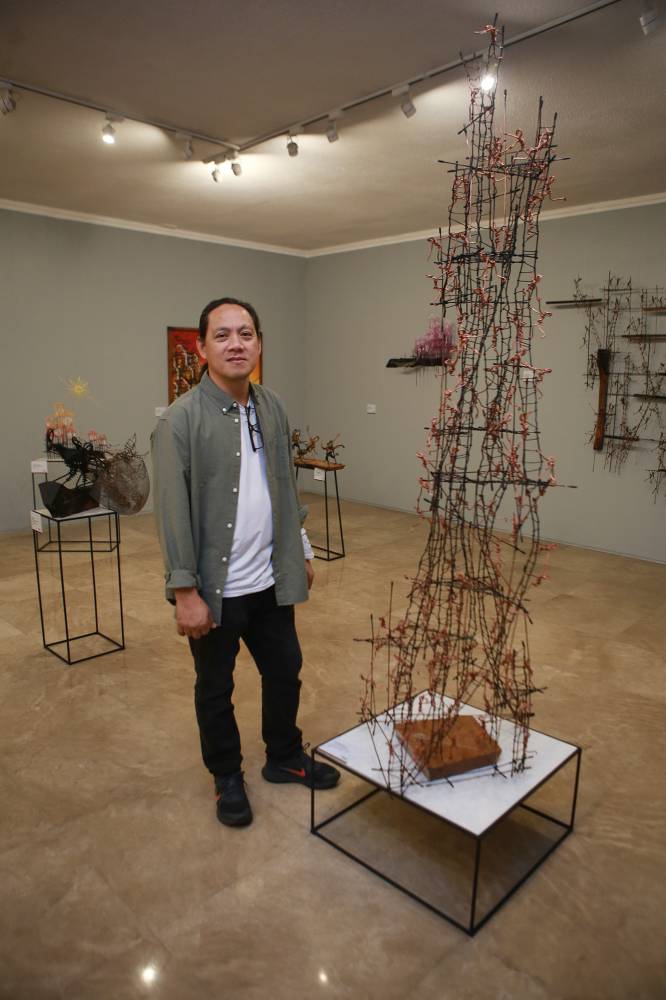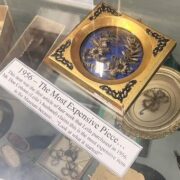The coiled odyssey of Ruben Jasareno’s KableArt

It is amazing how many twists and turns a person’s life can go through before they land where they’re supposed to. Sometimes it’s coiled, other times it’s straight, sometimes it snaps back, other times it stays the same—especially if you are a person with a multiplicity of talents and life choices.
Meet Ruben Jasareno. Born in Quezon Province in 1975, Jasareno was actually a seminarian, graduating in 1997 from Mount Saint Aloysius College Seminary in Gumaca before decamping to Pasig City (the priesthood was ultimately not for him) to teach theater arts at Pasig Catholic College, something he really enjoyed. Aside from that, Jasareno had a side gig. “At that time, they were replacing the coaxial cables being used for cable TV for fiber optic ones and after we retrieved them, the analog ones wound up dumped in my place,” he says in a mix of English and Filipino. The old cables were copper wrapped in rubber. He was doing so because part of his side gig was putting up CCTV cameras (he is indeed a man of many talents).
Back at Pasig Catholic, he continued to direct plays. “Then, senior high school started and I was assigned to teach arts.”That’s when he noticed something: When you put all the students together, they all displayed a different artistic skill. “Not all of them were visual artists,” he recalls. “Some were singers, others were dancers. Individuals had their own individual skills and I was inspired by that.”When he saw the visual artists in his class, that’s when Jasareno became interested in visual arts. “In theater, I would do the backgrounds, so this time, I decided to try a different discipline,” he explains. “But I had no medium. I didn’t paint. But then I noticed the wires just lying there. No one was using them, no one was buying them.”
So Jasareno began twisting the coaxial cables into small human figures and that started him on an entirely different direction.
He started getting better at it, and soon, he was making larger and larger installations and wire sculptures—but always populated with those small human figures. It was like he was building a world of wire that observed the world around and inside him.

‘Crossroads’
His very first piece was called “Crossroads,” finished in 2018, a comparatively small simple piece portraying a man dragging luggage as he decides where to go next. It’s made of coiled cable on a wooden base, and Jasareno had held on to it.
He looked forward to a world of goodness, where people got along and helped each other, and also replicated nostalgic everyday scenes of Filipino life.
He called his unique medium “KableArt” (pronounced “kab-leh-art”). He began consigning his work to an art trader he knew; at the beginning a Jasareno KableArt piece cost only P800 to P2,000.
He got his first big break in 2020 when the marketing manager for SM City Batangas saw his work and liked it. Noting that February was National Arts Month and the mall always needed content, the manager organized his first solo exhibit in 2021. When the area manager for SM saw it, he suggested taking the exhibit on tour, which was why “Kawad Stories” went around the various SM malls in the Southern Tagalog area.
His second solo show was titled “Malayang Pinoy” at SM Lucena City in 2022 because, the logic went, he was originally from Quezon. He’s also done some group shows, but he received much needed help when he received a Gawad Bagong Biswal grant from the National Commission for Culture and the Arts (NCCA).
At 48, he is a full-time artist, having quit his teaching gig (“I couldn’t teach online,” he admits). He now works out of his Cainta home which serves both as showroom and studio. He is married to wife Madette and is father to Emmanuelle, 22, Samuel, 21 and Simone, 16.
He has received his biggest exposure with his third solo exhibition, “Coaxing Gestures, Transverse Visuals: The KableArt of Ruben Jasareno,” which runs at the NCCA Gallery in Intramuros until the end of March.
There are 25 new pieces in all, with one piece made up of seven smaller ones (that one, “Los Cargadores,” had 30 figures in it). There is one piece that is a collaboration between him and daughter Simone (“Dapit Hapon”). And the ever-present “Crossroads,” of course.
The show’s title refers to how all his pieces have meaning, sending signals. “Pag-uwi” stands for homecoming, with the pieces showing students heading home to these houses practically built on top of each other.
Promoting positivity
There is definitely something he wants to promote: “The best signal is positivity. Take my ‘Ant Mentality.’ That’s really positive because it’s a counter-concept to crab mentality.” It shows people helping each other build something instead of tearing each other down.
The hardest part has been fighting imposter syndrome. “In visual arts, I’m older, I have all these ideas and there are all these other young talented artists,” he admits. In fact, he had tried for the NCCA grant three times before he got it, as well as others. “It feels good to get the grant, but I was nervous preparing for the show because big-time artists exhibit in this space.”
There is an upside to the biggest show of his career so far. “The best part was the applause during the opening last Feb. 7. I’m used to curtain calls when I was doing plays. I had friends who came to the opening whom I did not expect to attend.”
He’s so busy now, working on commissions for clients, and he just finished a new collection called “Doggos,” featuring dogs, of course.
Today, a Jasareno KableArt piece goes from P6,000 to P500,000, depending on the size and complexity of the piece. “Coaxing Gestures” can only increase the popularity of this artist who has finally broken through and continues to grow. He’s now using GI, aluminum and copper wires, and as “Coaxing Gestures” shows, his KableArt pieces are all sizes—some small enough to be mounted on a wall like a painting, others so massive they go all the way from the floor to the ceiling. His work is so diverse and yet still so intricate and fascinating that one could spend hours just looking at all the twists required to form these familiar figures—and then what it all means just hits you, like the joy of flying a kite on a windy day or a cold cone of dirty ice cream from a sorbetero.
Ruben Jasareno may have had taken a circuitous path to get to here but here he is, and he knows what he wants to give people viewing his art: “Because my treatments for the pieces in this show are so nostalgic, they will remind you of your childhood, like the time you skinned your knee when you were playing tumbang preso. It shows the lives of common people. I want them to leave with a smile. This was what I really set out to do when I started with KableArt. I want to give them a smile.” INQShow runs until March 31 at the NCCA Gallery, NCCA Building 633, Gen. Luna St., Intramuros, Manila.
Ruben Jasareno’s studio is at 14 Albatross St., Don Mariano Subdivision, Cainta, Rizal. Call tel. +63917-7177234; email direkruben@gmail.com.

















